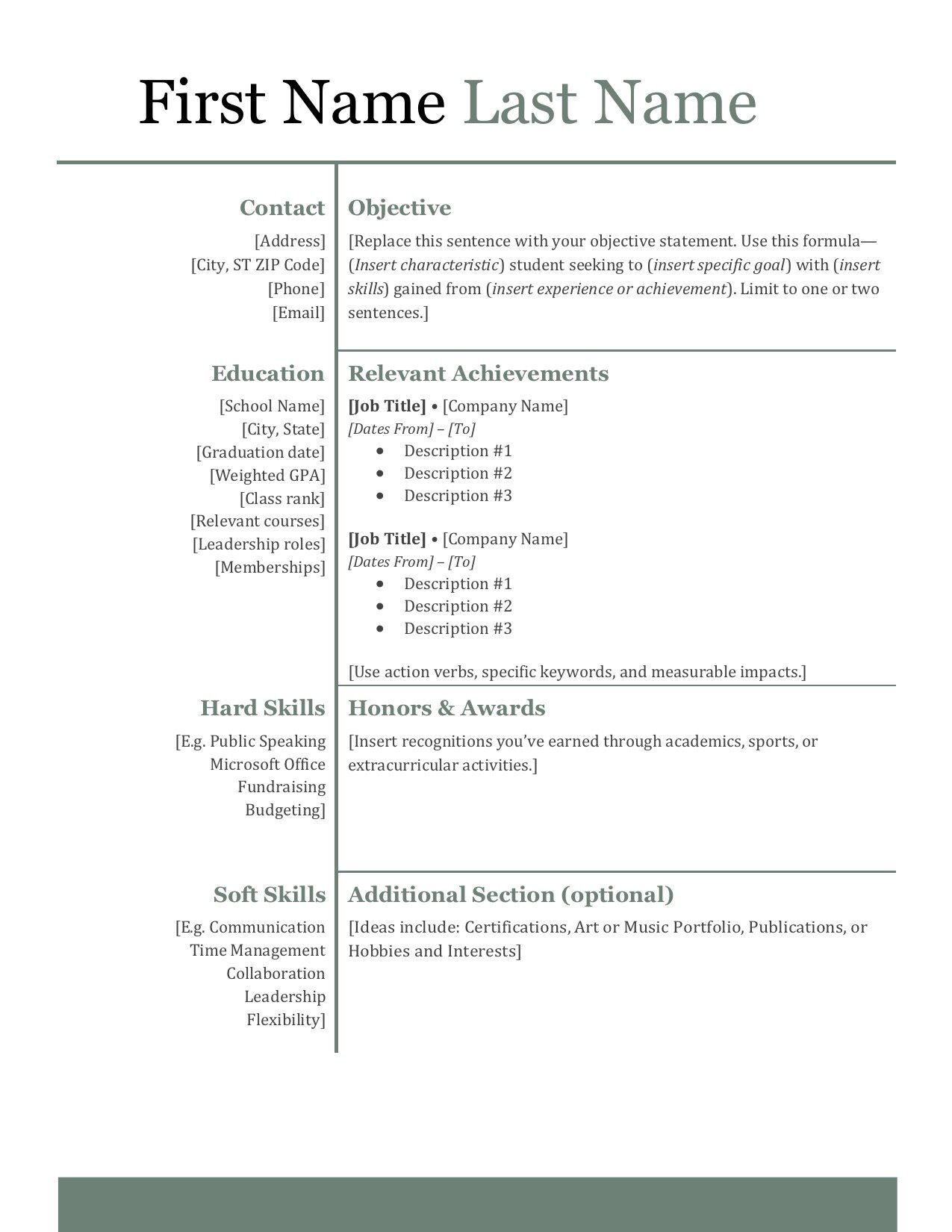How to Write an Impressive High School Resume
/A section-by-section guide to creating a stand-out high school resume, plus a personalized resume template
Introduction
If you’re a student sitting down to write your high school resume, you might be feeling a little lost. Where do you start? What should you write? Creating a resume isn’t easy for anyone, but it can be especially tricky when you’re a high school student without much work experience.
Maybe you need a high school resume to submit for a job or internship application. Or perhaps the college or scholarship you’re applying to requires a resume. Whatever your situation, you want to put your best foot forward on your high school resume.
A strong high school resume gives potential employers and colleges a quick but detailed and accurate snapshot of who you are and why they should be interested in getting to know you better. On the other hand, a weak or sloppy high school resume will end up in the waste basket in ten seconds flat. You’re hoping for the first option, of course.
If you’re asking yourself, “What skills can a high school student put on a resume?” or “How do you write a high school resume with no experience?” we’re here to answer those questions and more. Continue reading to find a step-by-step guide on how to create a stand-out high school resume, as well as a personalized high school resume template to give you a jumpstart on your resume writing process.
How to format a high school resume
Let’s start with the basics—formatting your high school resume. The good news is, you don’t have to start from scratch. We’ve created a modern high school resume template for you that’s perfectly suited to showcase your skills and experiences at any level. And if you’re a creative type looking to add extra personality to your resume, you might consider exploring the high school resume template options on sites like Canva.
What makes a good high school resume template, anyway? Here are a few of the most important formatting rules your resume should follow:
Limit your high school resume to one page.
Ensure your resume is skimmable by using big headings, bullet points, and plenty of white space.
Use classic and easy-to-read fonts, such as Cambria, Calibri, Georgia, Helvetica, or Garamond, to name a few.
Save your high school resume as a PDF file so the formatting won’t change when someone views or downloads it.
Once you’re set with a great high school resume template following these guidelines, your first step is to add your contact information. Here are a few tips on what to include:
Your first and last name. Don’t use a nickname here—you can get more casual after you’ve secured the job or internship.
A professional email address. The best email address is something simple, such as first.lastname@example.com. A silly, cute, or edgy email will not be impressive to potential employers or colleges.
The best phone number to reach you. Make sure you have a professional voicemail greeting in case you miss their call.
Your home address. While a potential employer is unlikely to send you a piece of mail, they might consider the length of your commute to the business location when reviewing your high school resume.
Optional: your LinkedIn profile or personal website. You might not have these yet, and that’s fine. If you do have a LinkedIn profile or personal website you’d like to share, make sure it’s professional and only contains information that will impress colleges and employers.
Once you’ve expertly added and arranged your contact info, you’re ready to move on to the next part of the high school resume—your objective statement.
How to write an objective statement for a high school resume
The objective statement on your high school resume is quite literally answering the question, “What is the purpose or objective of this resume?” While on the surface it may seem obvious—you want to get hired for a specific job or accepted to a specific college—you’ll need to dig deeper in order to write an impressive objective statement.
Your objective statement should provide three important pieces of information:
Why do you want this specific job or why do you want to attend this specific college?
What makes you the best candidate for this position or school?
How can this company or college help you reach your larger goals?
Oh, and you only have one or two sentences to share this important information. Piece of cake, right? Don’t worry, it’s easier than you think if you use a specific formula for writing your objective statement:
[Insert characteristic] student seeking to [insert specific goal] with [insert skills] gained from [insert experience or achievement].
You’ll understand this formula best if we use an example. Let’s say you’re applying to a graphic design internship at your local newspaper. You have a keen eye for detail, your goal is to tell impactful digital stories, you’re already skilled at using Adobe to create page layouts, and you have design experience from working on your school yearbook. Here’s an example objective statement for your high school resume:
Detail-oriented student seeking to amplify The Daily City Newspaper’s influence through digital storytelling. Gained expertise using Adobe Creative Suite while designing 25 page layouts and 12 advertisements for the Daily High School Yearbook.
Stating your goals, qualifications, and experiences in your objective statement lets the potential employer or college rep reading it know that your resume deserves their attention. And after piquing their interest, you can continue to impress them with your remaining high school resume sections.
What to include in the education section of a high school resume
Since you haven’t graduated high school yet, you might be feeling a little lackluster about writing the education section of your high school resume. But rest assured, there are plenty of enticing details you can include in this section to help you impress employers and colleges. Here’s a list of information you might add to your education section:
High school name and location.
Expected graduation date—the month and year will suffice.
Weighted GPA. This is an optional item to include if your GPA will impress the person reading your high school resume—a 3.5 or above, for example.
Class rank. Again, if it is impressive—the top 20% of your class, for example.
SAT or ACT score. Only include your scores in high school resumes for college and scholarship applications—potential employers won’t know what a good SAT score is (and likely won’t care too much, either).
Especially challenging and relevant coursework. Don’t include the standard high school curriculum, but you can list IB or AP classes you’ve taken that relate to the job or internship you’re applying for.
Leadership roles in clubs or sports—for instance, “Team Captain, Varsity Soccer.” Especially mention your extracurriculars that are relevant to the position you’re seeking.
Academic memberships. You can include your involvement in a college preparatory program or selective honors societies, if applicable.
We hope you’re pleasantly surprised that you can write more than, “high school diploma in progress” on your high school resume. Just by digging a little deeper, you’ll find plenty of information to include in your education section to help you stand out as the ideal job, internship, or college applicant.
How to write the work experience section of a high school resume
As we arrive at the biggest, most stressful section of a high school resume, we have to address a question we commonly get from students:
“How do you write a resume with no experience?”
Many students think because they haven’t worked an official job, they lack experience. But it isn’t true. Unless you’ve been sitting in a box for your entire life, you’ve earned experience worth putting on a high school resume—we just need to dig a little deeper to find it.
So what types of experiences can you include on your high school resume? Of course, if you have work experience—even if it’s for your family business and you weren’t an “official” employee—you should showcase it. But if not, don’t worry. Instead, you can share information about your high school internships, volunteer work, community service, club involvement, participation in sports, leadership positions, and even the challenging academic summer programs you’ve attended.
These types of activities are impressive to potential employers and colleges, so don’t be nervous if you’re writing a high school resume with no work experience. Be proud of the unique experiences you’ve had. You can even change the title of the section from “Work Experience” to “Relevant Activities” or “Major Achievements.”
How to write descriptions for your experiences on a high school resume
Once you’ve identified two to four experiences or activities to showcase on your high school resume, you face the challenging task of describing your involvement and duties. This is one of the most difficult and crucial parts of writing your resume—how you represent your experience can be the difference between securing a position or continuing your job search.
You want to use between three and five bullet points to describe each experience. Remember, your high school resume is limited to one page, so be strategic with every word. Illustrate your most recent or most relevant experiences in greater detail than your older or less-applicable experiences. For example, if you’re applying for a business internship, you should emphasize your experience as treasurer or marketing manager of a school club.
And what should each bullet point description contain? Here are a few guidelines to ensure your experience descriptions have the greatest impact:
Begin each bullet point with an action verb—such as created, completed, or managed. And you want to be careful not to use the same verb more than once. If you’re struggling to find the right words, use a list of resume action verbs to give you ideas.
Use condensed language. Exclude pronouns, conjunctions, and any unnecessary words. It’s not the style you’d use to write college essays, but it will make your high school resume more skimmable and effective. (Suggested reading: our college essay ebook)
Tailor your descriptions by using specific keywords. If your high school resume is for a job application, sprinkle in keywords used in the job description to represent yourself as the ideal employee for the position. If you’re applying to a college or scholarship, add keywords from their mission and values statements to prove you’re exactly the type of student they want.
Add numbers and results whenever possible. You might include the hours per week you devoted to the activity, how many customers you served, or the number of products you created. If you measurably impacted productivity or efficiency (for example, reduced paper waste by 20%), be sure to include it, too.
If you follow these guidelines, your high school resume will stand out from the crowd and dazzle every manager and admissions rep who reads it.
An example experience entry for a high school resume:
Retail Associate — Old Navy, Inc.
November 2018 - January 2020
Provided exceptional customer service to 200 guests daily, which included giving tailored product recommendations and answering questions about store policies.
Processed cash and card payments for products equalling over $3,000 per shift, while maintaining a balanced register.
Designed, executed, and maintained attractive product displays that increased sales of featured items by 15%.
What to include in the skills section of a high school resume
If you search for general resume examples online, you might feel overwhelmed and perhaps a bit discouraged when you look at sample “Relevant Skills” resume sections. But what you’re probably looking at are sample resumes for mid-career professionals. When you’re still in high school, you’re not expected to have the same advanced career skills as someone in their thirties does. This leaves you with the question, “What skills can a high school student put on a resume?”
The answer is: more than you think! When evaluating what skills you might be able to add to your high school resume, it’s helpful to understand the difference between hard skills and soft skills.
Hard skills refer to a person’s abilities gained through technical knowledge or training. These can range from technology or software skills to interpersonal skills such as public speaking or customer service. As a high school student, your hard skills may be limited, if you haven’t gained much work experience or training, but you’ve probably still acquired a few through school and extracurriculars.
Here are examples of hard skills you might be able to add to a high school resume. You should choose which skills to include based on the type of job, scholarship, or college you’re applying to.
Customer service
Public speaking
Microsoft Office
Graphic design
Social media
Fundraising
Budgeting
Research
Biliteracy
Soft skills, on the other hand, are personality traits that empower a person to be an exceptional employee or student. These types of skills can be gained in any setting, meaning you don’t need work experience to possess them. And while hard skills can be taught on the job, it’s much harder to teach a person to have good character, so you shouldn’t underestimate the importance of having soft skills.
Here are a few examples of soft skills that could be included on a high school resume.
Resolving conflict
Communication
Time management
Problem-solving
Teamwork
Attention to detail
Flexibility
Collaboration
Leadership
To strike an impressive balance on your high school resume, aim to include three or four hard skills and four or five soft skills—all relevant to the position or school to which you’re applying.
What additional sections to include on a high school resume
After you’ve completed the above sections, you might find you still have some space on your high school resume—and that’s good! It gives you an opportunity to further impress potential employers and colleges. Let’s explore the different types of sections you can add to round out your resume.
Honors and Awards. Many students will include this section in their high school resume because it’s the perfect way to showcase their academic, sport, and extracurricular achievements. You might include being on the Honor Roll, having perfect attendance, winning a sports championship, placing first in a robotics competition, or receiving a scholarship, to name a few examples.
Relevant certifications. If you’ve had the opportunity to complete training and earn certifications relating to the position you’re applying to—for instance, a CPR certification for a lifeguard or preschool assistant job—you might want to devote an additional section to those.
Portfolio or published works. If you’re an artist, writer, or other type of creative, you can add a section to your high school resume that specifically highlights your best creative achievements. For example, you can share the artwork you’ve publicly displayed, the poems you’ve had published, or the musical pieces you’ve performed.
Hobbies and interests. When submitting your high school resume with your college or scholarship applications, you might choose to add a section about your interests to come across more holistically or help the committee know you better. You can even present your hobbies in a fun and interesting way. For example, you might share your love of ice cream with a statement like, “Visited 40+ family-owned ice cream shops in my surrounding area.”
Remember, your high school resume is all about you. So tailor the focus of your additional sections to showcase your uniqueness and bring you closer to the job, internship, scholarship, or college you’re pursuing.
High school resume template
Final thoughts
Your high school resume will evolve over time as you gain new experiences, qualifications, and skills. But you have to start somewhere, and now’s the time to begin. We’ve provided all the information, tools, and ideas you need to create a high quality, professional-looking high school resume. With a resume like this in your pocket, many promising career and educational doors will open for you.






